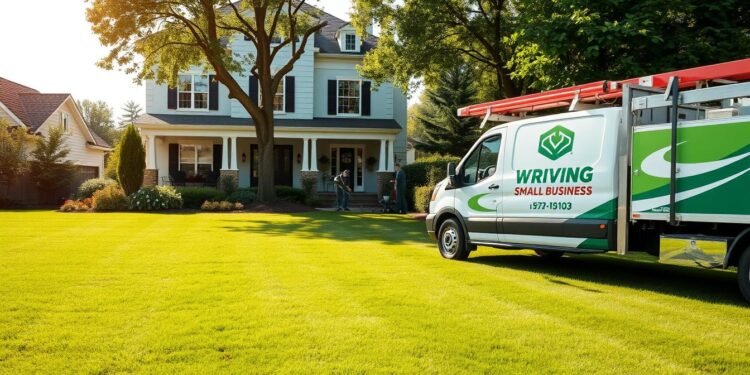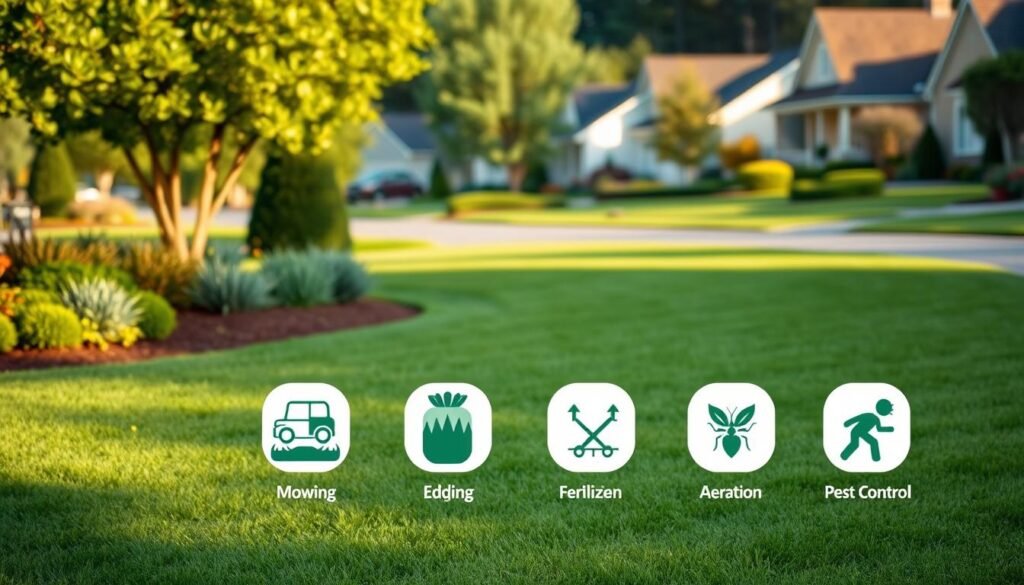Ever wondered why some lawn care ventures skyrocket while others struggle? Take Trevor Kokenge, who turned a $300 investment into a $29,000 monthly revenue stream. His secret? Combining passion with smart scaling strategies.
The lawn care industry is booming, with projections showing strong growth through 2025. But success requires more than just a mower and determination. Tools like Homebase streamline operations, while compliance software keeps licensing hassle-free.
Seasonal demand and equipment costs pose challenges, yet proven models exist. One entrepreneur nets $348k annually with just two employees. The right mix of planning and execution makes all the difference.
Key Takeaways
- The lawn care sector offers strong growth potential in coming years
- Strategic scaling transformed a $300 investment into six-figure revenue
- Operational tools like Homebase simplify business management
- Seasonal fluctuations require creative solutions for steady income
- Compliance software handles licensing and insurance paperwork
Is a Lawn Care Business Right for You?
Physical endurance and climate adaptability separate thriving operators from those who burn out quickly. This work demands more than mechanical skills – successful owners match their personal strengths to seasonal realities.
Assessing Your Interest and Skills
Can you handle eight-hour days pushing mowers in summer heat? The most profitable company owners enjoy outdoor labor. Office workers transitioning to this field often underestimate the physical toll.
Create a self-assessment checklist:
– Stamina for repetitive bending and lifting
– Tolerance for pollen, grass stains, and insect exposure
– Comfort with equipment maintenance tasks
Seasonal Work Considerations
Active months vary by region – northern operators average 5-7 months, while southern climates offer 9+ months of income. Smart owners develop winter alternatives like holiday lighting or gutter cleaning.
Storage solutions become critical during off-seasons. Many operators convert garage space or rent small units for equipment protection. This way prevents costly replacements each spring.
Identifying Your Niche
Specialization drives profitability. Eco-friendly treatments command 20-30% premiums in suburban markets. The LawnStarter survey shows 60% of pros reconsider clients due to pet waste issues – address this early in client agreements.
Premium landscaping services attract higher-value customers than basic mowing. Consider your starting lawn focus carefully – it’s easier to grow business upward than pivot later.
How to Start a Lawn Care Business: A Step-by-Step Plan
Successful green industry entrepreneurs treat their first year like a strategic blueprint rather than trial-and-error. Building a sustainable operation requires analyzing local demand while setting achievable financial targets.
Understanding the Market Demand
Homeowners aged 35-55 with quarter-acre lots generate 68% of residential landscape service revenue. Commercial properties add stability with year-round contracts, but residential clients offer easier entry for new operators.
Regional pricing benchmarks show $45-$75 hourly rates for basic mowing jobs. Upscale neighborhoods tolerate 20% premiums for eco-friendly treatments. Tools like Google Trends reveal seasonal search spikes to time your marketing.
Setting Realistic Goals
A commercial mower becomes profitable after approximately 120 service visits. Most operators reach break-even within eight months when maintaining a 10-mile service radius for fuel efficiency.
First-year earnings typically range $5,000-$50,000 according to LawnStarter data. Targeting 25 regular clients creates stability, while three-year projections often exceed $100k with proper scaling.
Your business plan should account for equipment depreciation and winter income alternatives. Many successful operators allocate 30% of summer revenue to cover off-season expenses.
Legal Requirements for Starting a Lawn Care Business
Navigating legal requirements separates professional operators from weekend landscapers. Proper documentation protects your business from fines while building trust with clients who verify credentials.
Business Licensing and Registration
State fees range $50-$200 annually for basic operation permits. Many municipalities require separate registrations for chemical applications.
An LLC structure offers personal asset protection, while sole proprietorships simplify tax form filing. Consult local Small Business Development Centers for jurisdiction-specific rules about lawn service payments and sales tax collection.
Insurance Needs
General liability coverage below $1 million makes bidding on commercial contracts impossible. Trailer endorsements on auto policies often cost less than standalone commercial vehicle insurance.
Hiring your first employee triggers workers’ compensation requirements in most states. Seasonal staff may qualify for limited-coverage plans during peak months.
EPA and Pesticide Certifications
The EPA 40 CFR 152 mandates proper chemical storage and handling training. Many states require passing scores on pesticide application exams before offering fertilization services.
OSHA compliance includes multilingual safety manuals when employing non-English speakers. Digital recordkeeping satisfies documentation requirements for most regulatory inspections.
Creating a Lawn Care Business Plan
Urban landscapes hide profit potential for operators who master service economics. A documented strategy separates sustainable ventures from seasonal side gigs. Your company roadmap should address three critical components.
Defining Your Services
Service menus require strategic engineering. Core mowing packages should cover 60% of your lawn maintenance revenue, while premium add-ons drive profitability. The $300 daily benchmark becomes achievable through tiered offerings:
– Basic: Mowing, edging, blowing ($45-65/service)
– Enhanced: Fertilization, weed control (+20% premium)
– Premium: Seasonal cleanups, aeration (50% higher margins)
Target Market Analysis
ZIP code income data reveals pricing ceilings. Neighborhoods with median incomes above $75k tolerate 15-20% higher rates for eco-friendly services. Convert this data into route efficiency:
• Cluster clients within 2-mile radii
• Prioritize properties with irrigation systems
• Flag households with pets for special pricing
Financial Projections
First-year models should target 35% gross margins. At 15 weekly clients paying $50 per service, you’ll generate $3,000 monthly income. Factor in equipment depreciation at 20% annually for accurate forecasting.
Financing options impact cash flow. SBA loans offer better terms for money management than equipment leases. Calculate customer lifetime value at $1,200+ per account when projecting three-year growth.
Your business plan becomes operational when break-even analysis meets route optimization. Document every assumption – this living guide evolves with your venture.
Choosing Your Lawn Care Services
Strategic service selection separates profitable lawn care operations from those barely breaking even. A well-designed menu balances reliable income from routine work with higher-margin specialty offerings. Industry data shows operators bundling services achieve 68% greater annual revenue than those offering single solutions.
Core Services That Build Client Loyalty
Lawn mowing forms the foundation, with weekly visits generating predictable income. Pair this with edging and blower cleanup for complete turf maintenance. Smart operators offer tiered packages:
• Basic (mowing only) at $35-$50 per visit
• Standard (mow/edge/blow) commanding $50-$75
• Premium packages with fertilization add-ons
Seasonal Add-ons for Year-Round Income
Transform summer operations into twelve-month revenue streams. Snow removal contracts net $150-$300 per property in winter months. Fall leaf cleanup pairs naturally with gutter services in northern climates.
Consider climate-specific opportunities like hurricane debris removal or drought-resistant landscaping in arid regions. These prevent the feast-or-famine cycle many operators face.
Specialized Offerings That Boost Margins
EPA Section 3 certified fertilization services deliver 45-60% profit margins. Invest in a trailer-mounted aerator for heavy clay soil treatments. Dethatching equipment pays for itself within 20 jobs in high-rainfall areas.
Educate clients with seasonal lawn health guides. This positions you as an expert while creating natural upsell opportunities for pest control or irrigation services.
Pricing Strategies for Lawn Care Services
Smart pricing transforms seasonal work into sustainable income streams for landscape professionals. The $0.05-$0.20 per square foot industry standard only tells part of the story—successful operators adjust for neighborhood demographics and service complexity.
Hourly vs. Flat-Rate Pricing
Flat-rate models build trust with clients through predictable billing, while hourly rates protect your business on complex jobs. Conduct time-motion studies to standardize service durations before setting fixed prices.
Early-payment discounts (2%/10 net 30 terms) improve cash flow with both models. Fuel surcharge clauses prevent margin erosion when gas prices spike unexpectedly.
Competitive Rate Analysis
Secret shop three local competitors to benchmark trimming frequencies and cleanup standards. Upscale neighborhoods often tolerate 15-20% premiums for eco-friendly service packages.
CRM systems track historical pricing data to identify seasonal demand patterns. Dynamic pricing works best when paired with route optimization for clustered customers.
Profit Margin Considerations
Maintain 18-35% gross margins by factoring equipment depreciation and travel time. Commercial contracts should account for 25% overhead costs versus 15% for residential income streams.
Remember: The right pricing strategy turns lawn maintenance from a job into a scalable enterprise. Review rates quarterly using fuel indexes and labor cost adjustments.
Essential Equipment for Your Lawn Care Business
Commercial-grade tools transform yard work into a scalable operation with measurable profits. The $8,000 investment in a professional mower often pays for itself within 120 jobs, while proper storage solutions prevent costly off-season damage.
Basic Tools That Get the Job Done
Walk-behind mowers with 21-30″ decks handle most residential properties efficiently. Commercial models feature reinforced decks and commercial-grade engines that last 3x longer than consumer versions.
String trimmers and backpack blowers complete the core toolkit. Look for models with easy-start systems and vibration reduction for all-day comfort. Electric options gain popularity in urban areas with noise restrictions.
Moving Your Operation Efficiently
A $5,000 used truck with a trailer often outperforms cargo vans for payload capacity. Enclosed trailers with ramp gates protect gear while allowing quick unloading at multiple stops.
Calculate fuel efficiency when planning routes. Lightweight aluminum trailers improve gas mileage by 15-20% compared to steel models, making them worth the premium for high-mileage operators.
The Purchase Versus Rent Equation
Rental makes sense for specialized equipment like aerators used seasonally. The break-even point typically occurs after eight rentals – beyond that, purchasing saves money.
Maintenance costs factor heavily into ownership decisions. Commercial-grade gear requires 30% less servicing than residential models, despite higher upfront costs.
Building Your Lawn Care Brand
A cohesive visual identity transforms your operation from anonymous mowing crews to a trusted local business. Studies show professionally branded companies enjoy 73% higher client retention—your logo and uniforms silently communicate reliability before you even knock on doors.
Business Name and Logo
Your company name should be memorable yet descriptive. “GreenPro Lawn Care” tests better than generic options in focus groups. Always conduct a USPTO trademark search before finalizing.
Invest in vector-based logo design for scalability. The best designs work equally well on truck doors and website favicons. Avoid clipart—custom illustrations build distinctiveness.
Uniforms and Vehicle Branding
OSHA-compliant safety colors (neon yellow/green) make crews visible while reinforcing your brand. Embroidered shirts with moisture-wicking fabric outperform printed tears that fade.
Full-vehicle wraps generate 2,500+ daily impressions at $3,000-$5,000 investment. Calculate ROI by tracking how many customers mention “seeing your trucks around town” when calling.
Creating a Professional Image
Optimize your Google Business Profile with before/after photos and service area pins. Consistent branding across all marketing materials establishes credibility—use the same fonts and colors everywhere.
Develop brand voice guidelines for emails and texts. Phrases like “Your lawn care specialists” position you as experts rather than laborers. Portfolio books at estimates convert 40% more leads.
Remember: Every interaction should reinforce why your service justifies premium pricing. From branded invoice templates to crew conduct, professionalism pays dividends.
Marketing Your Lawn Care Business
Strategic promotion transforms local lawn maintenance into a booked-solid operation. The right marketing mix attracts ideal clients while maximizing your advertising budget. Balance digital outreach with neighborhood visibility for year-round lead generation.
Building Your Online Presence
A mobile-friendly website serves as your 24/7 salesperson. Showcase before/after photos and service areas with clear contact options. Google Business Profile optimization doubles visibility for local searches like “lawn mowing near me.”
Social platforms drive engagement differently. Facebook excels for sharing seasonal tips and promotions, while YouTube tutorials demonstrate your expertise. Nextdoor neighborhood groups generate hyper-local leads when you share lawn care insights.
Local Advertising That Converts
Door hitters yield 1 conversion per 100 distributed when designed effectively. Use Canva templates featuring your contact info and a limited-time offer. Target specific streets where you already have jobs to create route density.
Geo-targeted Facebook ads perform best with $5 daily budgets focusing on homeowners aged 35-55. Highlight unique value propositions like pet-safe treatments or same-day service guarantees in your creatives.
Powerful Referral Systems
Satisfied customers become your best sales team when incentivized properly. A tiered program offering $50 credits for every three referrals keeps leads flowing. Include referral cards with every invoice.
Google Local Services Ads certification builds trust while capturing high-intent searches. Display your badge prominently on all materials to highlight background-checked professionalism.
Finding and Retaining Customers
Local relationships fuel growth more than any ad campaign in the green industry. The most successful operators convert 93% of free lawn assessments into paying customers by combining trust-building with strategic follow-ups. Your approach should balance neighborhood visibility with systems that turn one-time jobs into recurring revenue.
Networking With Local Homeowners
Chamber of Commerce members report 28% higher conversion rates on local leads. Attend neighborhood association meetings with free soil pH test offers—this diagnostic service positions you as an expert while collecting contact details.
Offering Trial Services
Limited-time promotions remove risk for hesitant homeowners. Structure your offer with clear boundaries—perhaps three mows at 20% discount. Track conversion patterns to identify which neighborhoods yield the best long-term client matches.
Collecting and Showcasing Reviews
Google reviews multiply your visibility while building social proof. Provide simple email templates asking for feedback after completed jobs. Loyalty programs like “10th mow free” encourage repeat business while giving more time to nurture relationships.
CRM systems automate birthday greetings and service reminders. Pair this with ironclad guarantee policies—offering to redo unsatisfactory work within 24 hours eliminates purchase anxiety for new customers.
Managing Daily Operations
Efficient operations separate thriving lawn care businesses from those stuck in survival mode. Smart management systems turn unpredictable work into streamlined processes that save time and fuel. Modern tools now automate what used to consume hours of a day.
Scheduling and Route Planning
Route optimization cuts fuel costs by 22% according to landscape industry studies. Apps like Homebase automatically cluster nearby jobs while accounting for traffic patterns.
Create morning checklists that include equipment checks and crew assignments. Digital calendars with GPS tracking help adjust routes when unexpected delays occur.
Customer Communication
Two-way texting platforms resolve 80% of client questions faster than phone calls. Set up automated reminders 24 hours before each service visit.
Client portals allow easy rescheduling while maintaining your route density. Always confirm completed work with timestamped photos sent via text or email.
Weather Contingencies
Rainy days become equipment maintenance opportunities when planned ahead. Keep a prioritized task list for shop work during weather delays.
Communicate schedule changes immediately using templated messages. Fuel tracking spreadsheets help adjust purchasing when storms alter your weekly route mileage.
Hiring and Managing Employees
Growth demands often reveal the right moment to bring additional hands on deck in any service operation. The transition from solo operator to employer requires careful planning around labor costs and safety compliance. Industry benchmarks show most landscape companies hire their first crew member after reaching 25 regular clients.
When to Hire Your First Employee
Consistent overtime hours and declined work requests signal hiring readiness. The $15-$20/hour wage range attracts quality candidates in most markets while maintaining profitability. Workers’ compensation insurance averages $2.57 per $100 payroll – factor this into pricing models.
Key hiring indicators include:
– Routinely turning down new clients
– Equipment sitting idle due to time constraints
– Customer complaints about scheduling delays
Training and Safety Protocols
OSHA 10-hour certification reduces workplace injuries by 42% in green industries. Develop multilingual training materials for equipment operation and chemical handling. Performance bonuses tied to safety records encourage vigilance among crew members.
Essential training components:
– Hands-on mower and trimmer demonstrations
– Emergency response drills
– Weekly toolbox safety talks
– PPE fit testing sessions
Payroll and Compliance
Quarterly tax filings and I-9 verification prevent costly penalties. Cloud-based management systems automate wage calculations and benefit deductions. Non-compete agreements protect your client base when hiring experienced employees.
Critical payroll considerations:
– State-specific meal break requirements
– Overtime thresholds for seasonal people
– Certified payroll for municipal contracts
– Electronic pay stub accessibility
Building a reliable team transforms your capacity to deliver consistent service. Proper business systems turn staffing challenges into competitive advantages.
Scaling Your Lawn Care Business
Strategic expansion separates local lawn services from regional powerhouses in the green industry. Operators who systematically grow business operations often achieve 200% revenue increases within three years through targeted acquisitions and service diversification.
Adding Services and Equipment
Market gap analysis reveals untapped revenue streams. Commercial property management services often require irrigation system maintenance—a high-margin add-on with 45% profitability.
Qualify commercial accounts by evaluating contract length and payment terms. Municipal bids typically demand $2 million liability coverage but provide steady winter income.
Expanding to New Areas
GPS fleet tracking optimizes route density when adding territories. Systems like FleetCost show real-time fuel consumption across multiple crews.
Standardized training ensures consistent service quality during expansion. Digital checklists help maintain brand standards across growing teams.
Franchising Opportunities
Franchise disclosure documents require detailed operations manuals. Established company systems become valuable intellectual property for franchisees.
Exit strategies should consider equipment valuation. Professional appraisals help maximize resale value when transitioning ownership.
Using Technology to Streamline Your Business
Digital solutions transform chaotic scheduling into streamlined processes for green industry pros. The right tech stack can reduce administrative tasks by 60%, letting you focus on growing your business and serving clients better.
Lawn Care Business Software
Platforms like Homebase simplify crew management and time tracking. Integrated systems sync with QuickBooks for seamless accounting and payments processing.
Look for features like:
– Equipment maintenance alerts
– Chemical application logs
– Tax document generation
Mobile Apps for Scheduling and Invoicing
Field service apps optimize routes based on real-time traffic and job locations. Some solutions incorporate drone mapping for accurate lawn assessments before visits.
Top performers offer:
– GPS crew tracking
– Photo documentation
– Instant estimate approvals
Automating Customer Communications
AI chatbots on your website capture leads 24/7 while automated texts confirm appointments. Set up reminders for seasonal service packages to boost retention.
Effective systems include:
– Payment receipt automation
– Review request triggers
– Weather delay notifications
Conclusion
Building a thriving lawn care operation requires equal parts passion and planning. Trevor’s journey from $300 to $348k annual revenue proves what’s possible with the right systems in place.
Focus on compliance foundations first—proper licensing and insurance protect your business as you scale. Tools like Homebase streamline scheduling and payments, freeing time for client growth.
Remember these key metrics: 25 regular clients create stability, while commercial accounts boost winter income. Specialized services like aeration deliver higher margins than basic mowing alone.
Ready to turn your green industry dreams into reality? Register your venture today and explore advanced strategies like fleet tracking and municipal contracts. Your success story starts now.
FAQ
What equipment is needed for a lawn care business?
Basic tools include a reliable mower, trimmer, blower, and safety gear. A truck or trailer helps transport equipment. Consider commercial-grade brands like Toro or Husqvarna for durability.
How much money can be made in lawn care?
Earnings vary based on location, services, and client base. Many operators earn – per hour. Scaling with additional services like landscaping boosts income potential.
Do I need a license to start mowing lawns?
Licensing depends on local regulations. Some areas require a business license, while others mandate pesticide certification. Check state and county rules before launching.
How do I price lawn mowing services competitively?
Research local rates first. Flat-rate pricing per job often works better than hourly charges. Factor in travel time, lawn size, and frequency to stay profitable.
What’s the best way to attract customers?
Build an online presence with a simple website and Google My Business listing. Offer discounts for referrals and use door hangers in targeted neighborhoods.
Should I rent or buy lawn care equipment initially?
Buying is cost-effective for long-term use, but renting lowers upfront costs. Start with essentials like a mower and upgrade as revenue grows.
How do I handle lawn care in bad weather?
Have a flexible schedule and communicate delays promptly. Offer rain-check services or seasonal add-ons like snow removal to maintain income year-round.
What insurance is required for a lawn care company?
General liability insurance covers property damage or injuries. Workers’ compensation is needed if hiring employees. Equipment insurance protects expensive tools.
How can I differentiate my lawn care business?
Specialize in eco-friendly treatments, premium landscaping, or smart irrigation. Branded uniforms and professional invoicing also build credibility.
When should I hire employees for my lawn care business?
Expand your team when workload exceeds 30+ hours weekly. Train staff on safety and customer service to maintain quality as you grow.










